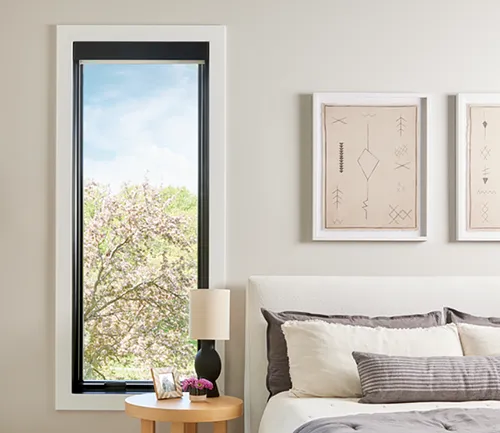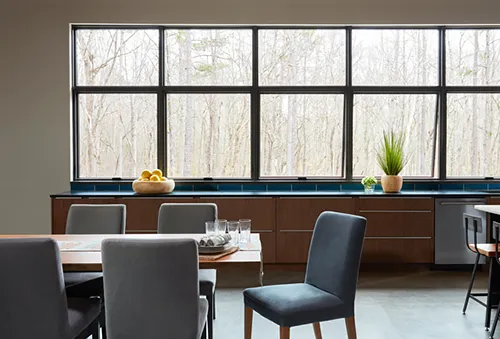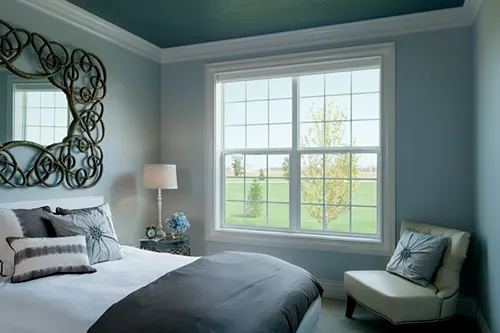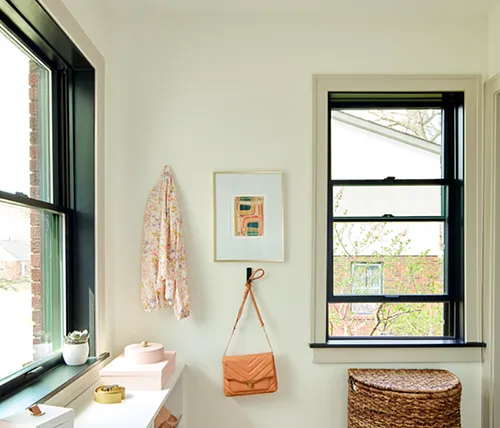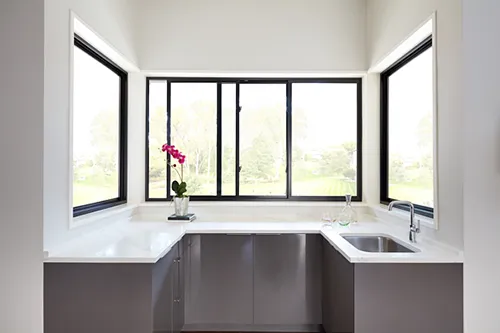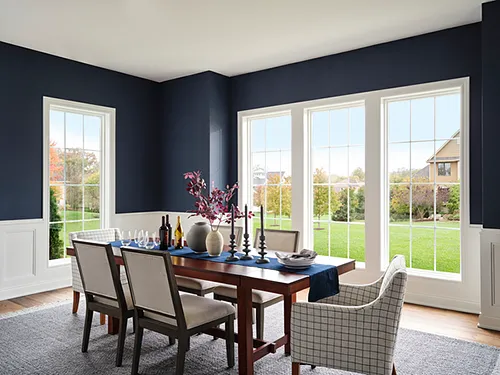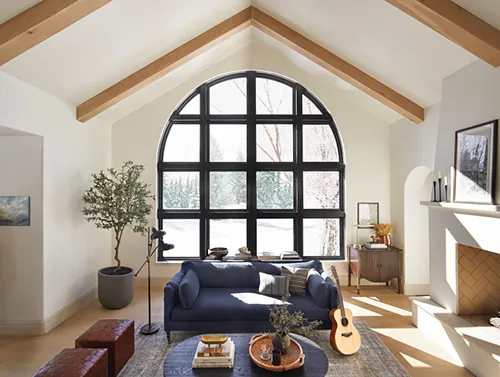How Different Window Types Compare
by Rachel Lyon, Editorial Director for The House Designers
Selecting windows proves a challenge for many aspiring homeowners. Not only do windows contribute to curb appeal on the outside, but they also affect the view from indoors. Of course, each type also has practical considerations to keep in mind. Whether you want to focus on form or function—or both—knowing your options is the first step.
Framed artwork or window? It’s both!
Casement windows without divided lites are ideal if you want to take in views.
Pella® Lifestyle Series Wood Casement Windows with Triple-Pane AdvancedComfort insulated glass offer exceptional performance, too—they were recognized as the Most Efficient of ENERGY STAR
® 2022!
Casement Windows
Popular across all architectural styles, casement windows swing open from the side and are great for creating cross breezes through the house. Clear panes offer a chic look for contemporary designs, but you can add grilles for a traditional touch. Explore some different patterns—what works for a farmhouse might not have the right feel for a Craftsman or European home!
Casement windows are easy to operate with a push-out or fold-away crank mechanism, so they are often placed in hard-to-reach areas, like behind the kitchen sink, even in homes that primarily use other types of windows. Just be aware of clearance issues—you don’t want to swing the window into an obstruction or create a hazard for a pathway outside.
Awning Windows
They are similar to casement windows in that they swing open from an edge, but awning windows are hinged on top. By pushing out from the bottom, they naturally shelter the opening they create, so you don’t have to worry about rain pouring inside if you forget to close them.
Hinged windows are supported by their longest sides—that’s why you’ll see tall casement and squat awning windows. Wider than they are tall in most cases, awning windows are a favorite for high applications, like over a shower for ventilation or in the basement to shine natural light down inside. Of course, they can also be square in shape and you can place them wherever it works for you. Just keep clearance in mind!
Single-Hung Windows
With a long history of being used in farmhouses and cottages, single-hung windows offer a more traditional vibe. Most homeowners finish them with grilles to tailor their style, but you can also go without, if you prefer. As a sliding window, there will always be a horizontal meeting rail in the middle, so hung windows don’t provide views as clear as their hinged counterparts.
Single-hung windows feature a fixed top sash and a moveable bottom sash. Just slide the bottom sash up to let fresh air in! Since the sash moves completely within its frame, you don’t have to worry about clearance, but you do have to be able to reach the window and have enough leverage to push it up. Consider the height of the placement and whether you can stand directly in front of it—obstructions like countertops and furniture will make hung windows difficult to use.
Double-Hung Windows
They might look like single-hung windows at first glance, but double-hung windows go a step further. The top and bottom sashes both move to create a stack or chimney effect. When you have high and low openings, hot air from inside rises out and cooler air is pulled in through the bottom. Historical homes used double-hung windows for natural air conditioning back in the day!
When it comes to installation, the only practical difference between single- and double-hung windows is the accessibility of the top sash. If you’d like to use them for their uniquely efficient ventilation capabilities, you’ll need to be able to reach the top of the window.
Sliding Windows
If you like the space-saving, no-swing operation of hung windows but need something more contemporary, sliding windows will serve you well. They have side-to-side operation, so they’re ideal for areas where you need a window wider than it is tall—think over a countertop or cubbies, or just somewhere that you want to limit the view inside by not bringing the window close to the floor.
It's amazing what difference 90 degrees makes when it comes to style! Sliding windows also have a middle meeting rail, of course, but it’s oriented perpendicular to the floor. Views sectioned by a vertical rail feel clearer because they don’t compete with the horizon. So, don’t think you’re locked into hinged windows—the sliding variety can provide plenty of fresh air without clearance concerns.
Fixed Windows
Homeowners opt for fixed or picture windows—those that don’t open at all—for a few reasons. First of all, you can get all sorts of shapes in this category. Whether you want to fill the space under a vaulted ceiling or place a unique porthole to frame a view, they have you covered. They also come in expanded sizes, so you can really bring the outdoors in. When you don’t have to worry about operation, you can get more creative!
Fixed windows are often used in tandem with other types. For example, you may see large fixed windows as the centerpiece of a modern wall of glass, but casement and awning windows are usually also included to provide ventilation. In traditional designs, you can find picture windows flanked by hung windows for the same reason. Fixed windows cannot count as a point of egress, so if you want to include them in a bedroom, you’ll also need to include a window that opens.
Custom Windows
We’ve covered the most common types of windows, but the possibilities are much wider! Custom windows give you the opportunity to craft something perfect for your home whether you’re renovating or building new. One thing to keep in mind is that all custom windows have wood frames, as opposed to vinyl or fiberglass, because it’s a more flexible material to work with. So, be sure to look in the right area, and don’t hesitate to contact a professional who can help you bring your ideas into reality!
Whether you have traditional, transitional, or contemporary tastes, explore the window options available from Pella®! They have a variety of vinyl, fiberglass, and wood products spanning all common window types, so you won’t be lost for lack of options. Find a showroom or schedule a free consultation to discuss the possibilities today!



.png)
.png)
